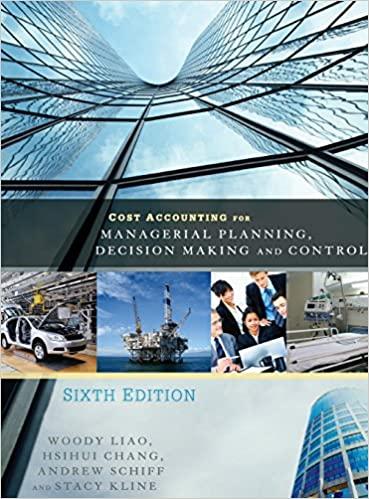Ollie Mace has recently been appointed controller of a family owned manufacturing enterprise. The firm, S. Dilley
Question:
Ollie Mace has recently been appointed controller of a family owned manufacturing enterprise. The firm, S. Dilley \& Co., was founded by Mr. Dilley about 20 years ago, is \(78 \%\) owned by Mr. Dilley, and has served the major automotive companies as a parts supplier. The firm's major operating divisions are heat treating, extruding, small parts stamping, and specialized machining. Sales last year from the several divisions ranged from \(\$ 150,000\) to over \(\$ 3,000,000\). The divisions are physically and managerially independent except for Mr. Dilley's constant surveillance. The accounting system for each division has evolved according to the division's own needs and to the abilities of individual accountants or bookkeepers. Mr. Mace is the first controller in the firm's history to have responsibility for overall financial management. Mr. Dilley expects to retire within six years and has hired Mr. Mace to improve the firm's financial system. Mr. Mace soon decides that he will need to design a new financial reporting system that will:
1. Give managers uniform, timely, and accurate reports on business activity. Monthly divisional reports should be uniform and available by the 10th of the following month. Company wide financial reports also should be prepared by the 10th.
2. Provide a basis for measuring return on investment by division. Divisional reports should show assets assigned each division and revenue and expense measurement in each division.
3. Generate meaningful budget data for planning and decision-making purposes. The accounting system should provide for the preparation of budgets which recognize managerial responsibility, controllability of costs, and major product groups.
4. Allow for a uniform basis of evaluating performance and quick access to underlying data. Cost center variances should be measured and reported for operating and non-operating units including headquarters. Also questions about levels of specific cost factors or product costs should be answerable quickly.
A new chart of accounts, as it appears to Mr. Mace, is essential to getting started on other critical financial problems. The present account codes used by divisions are not standard.
Mr. Mace sees a need to divide asset accounts into six major categories, i.e., current assets, plant and equipment, etc. Within each of these categories, he sees a need for no more than 10 control accounts. Based on his observations to date, 100 subsidiary accounts are more than adequate for each control account.
No division now has more than five major product groups. The maximum number of cost centers Mr. Mace foresees within any product group is six, including operating and non-operating groups. He views general divisional costs as a non-revenue producing product group. Altogether, Mr. Mace estimates that about 44 natural expense accounts plus about 12 specific variance accounts would be adequate.
Mr. Mace is planning to implement the new chart of accounts in an environment that at present includes manual records systems and one division which is using an EDP system. Mr. Mace expects that in the near future most accounting and reporting for all units will be automated. Therefore, the chart of accounts should facilitate the processing of transactions manually or by machine. Efforts should be made, he believes, to restrict the length of the code for economy in processing and convenience in use.
Required.
(a) Design a chart of accounts coding system that will meet Mr. Mace's requirements. Your answer should begin with a digital layout of the coding system. You should explain the coding method you have chosen and the reason for the size of your code elements. Explain your code as it would apply to asset and expense accounts.
Step by Step Answer:

Cost Accounting For Managerial Planning Decision Making And Control
ISBN: 9781516551705
6th Edition
Authors: Woody Liao, Andrew Schiff, Stacy Kline





